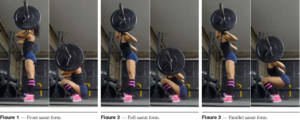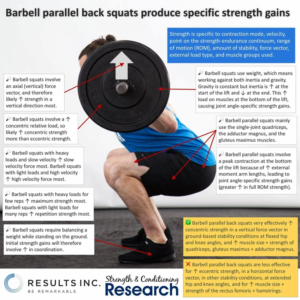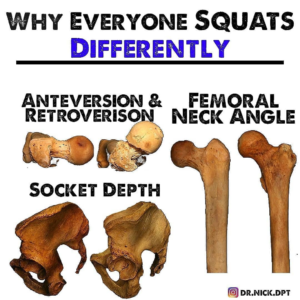2 LEG SQUATS – DEPTH – RESEARCH
Click on Image to Enlarge
MRI MEASURED: MUSCLE MASS INCREASE
TEST SCORES: POWER – SPEED
QUADRICEPS
– Full Squats 120º of Knee Flexion vs. Half Squats 60º Knee Flexion
Effect of range of motion in heavy load squatting on muscle and tendon adaptations – 2013- Bloomquist
Procedure

– 17 Male students 2 wks; compare effects of squats with a short vs. long ROM
Results
1. Deep squat 120° of knee flexion: superior increases in front thigh muscle CSA (4-7 %)
2. Shallow squat 60º of knee flexion: changes in proximal not distal
3. CMJ – Counter Movement Jump: height increased 13 ± 2 % in the DS group and 7 ± 4 % in the SS group
4. SJ – No Counter Movement Squat Jump Knee Angle @90º: height increased 15 ± 3 % in the DS group and 3.5% in the SS Group
POWER & SPEED
– Back Squat: Full, Parallel, Half
 Full squat produces greater neuromuscular and functional adaptations and lower pain than partial squats after prolonged resistance training – 2019 – Pallares
Full squat produces greater neuromuscular and functional adaptations and lower pain than partial squats after prolonged resistance training – 2019 – Pallares
Procedure
– 53 resistance-trained men: full squat (F-SQ), parallel squat (P-SQ), half squat (H-SQ)
-10-week velocity-based RT programme using the same relative load (linear periodization from 60% to 80% 1RM), only differing in depth of squat
– Neuromuscular adaptations were evaluated by 1RM and mean propulsive velocity (MPV) at each squatting depth. Functional performance was assessed by countermovement jump, 20-m sprint and Wingate tests. P
Results
Counter Movement Jump: Full Squat 13% . Parallel Squat 9% . Half Squat 7%
20 meter Sprint: Full Squat 2.3% . Parallel Squat 0.9% . Half Squat 0.0%
MRI STUDY
GLUTES, QUADS, ADDUCTORS, HAMSTRINGS
– Full Squats 140º Knee Flexion vs. Half Squats 90º Knee Flexion
Effects of squat training with different depths on lower limb muscle volumes – 2019 – Kubo
Procedure

– 17 untrained males completed 10 wks (2 days per week) of squat training
(1) full squat training group to 140° knee flexion
(2) half squat training group to 90º knee flexion
Results
Gluteus Maximus: full squat 6.7% . half squat 2.2%
Adductors: full squat 6.2% . half squat 2.7%
Rectus Femoris: no change
Vastus Medialis: full squat 6.7% . half squat 6.7%
Vastus Lateralis: full squat 6.6% . half squat 6.1%
Vastus Intermedius: half squat 4.7% . full squat 3.5%
MOMENT ARM STUDIES
MOMENT ARMS – GLUTE MAX, AD-DUCTOR MAGNUS, QUADS, HAMSTRINGS
– Squat @50%RM and @90%RM with Knee Flexion Angles of 30º 60º 90º 105º
Relative Muscle Contributions to Net Joint Moments in the Barbell Back Squat – Vigotsky, Bryanton – 2016
Procedure
– 10 resistance-trained women; squats using 50 and 90% 1RM
– estimated muscle moment contributions
Results
1. Gluteus Maximus – GM: in higher squat positions, the GM has similar contributions as the AM in generating a hip extension moment. However, the decreasing moment arm with increasing depth does not allow the GM to generate large hip extension moments in deep flexion; the relative moment contributions of the GM do not appear to differ substantially between 50 and 90% 1RM
2. Ad-ductor Magnus – AM: appears to play a pivotal role in hip extension during squats, producing, on average, >50% of net hip extension moment; this is most apparent in positions of greater squat depth and lighter loads. This is likely due to its larger hip extension moment arm in positions of greater hip flexion.
3. Quadriceps: Increased role of Hams at the hip with greater loading has implications for Quads; a greater hip extension moment produced by the Hams necessarily means a greater knee flexion moment which must be countered by Quads to produce a sufficient net knee extension moment
– Rectus Femoris: it doesn’t appear to contribute to the knee extension moment in squats, likely due to its biarticular nature. The hip extensors may not be able to produce a large enough moment to overcome both external and internal hip flexion joint moments. In EMG studies the RM seems to be highly active. However, the RM is highly susceptible to crosstalk from the Vastii. Fonseca found the Vastii, not the RM, hypertrophied following a back squat-only program.
4. Hamstrings: The Hams and AM appear to play a complementary role in hip extension; if the AM cannot produce a larger hip extension moment with increased load, the Hams increase their relative contribution in order to compensate.
EMG STUDIES
GLUTE MAX, RECTUS FEMORIS, V. LATERALIS, V. MEDIALIS, ERECTOR SPINAE
– Squats Partial & Full
Muscle Activation Differs Between Partial and Full Back Squat Exercise With External Load Equated – 2022 – da Silva
Procedures
– external load equated on a relative basis between conditions
– 15 young resistance-trained men performed a back squat at 10 repetition maximum (10RM)
1. Partial: 90º Knee Flexion
2. Full: 140º Knee Flexion
Results
Gluteus Maximus GM: Partial 20 . Full 15
Rectus Femoris – RF: Full 65 . Partial 60
V. Lateralis – VL: Partial 60 . Full 55
V. Medialis – VM: Partial 50 . Full 50
Erector Spinae – ES: Partial 45 . Full 45
GLUTEUS MAXIMUS & MEDIUS, QUADS, ADDUCTOR LONGUS, ERECTOR SPINAE
– Full & Parallel Back Squat, Full Front Squat, Wide Squat, Wide Squat with toes out
Glutes, Quads, Adductor Longus, and Lower Back in Different Squat Variations Performed by Competitive Bodybuilders – 2021 – Coratella
Procedure
– 10 male competitive bodybuilders perform back-squat at 80% 1-RM:
(1) full back squat (F-BS)
(2) parallel back squat (P-BS)
(3) wide stance – sumo (WS-BS)
(4) wide stance sumo feet external rotated (WS-ER-BS)
(5) parallel front-squat (P-FS)
Results
Gluteus Maximus: Parallel Front 80 . WS-ER-BS 65 . Parallel Back 60 . Full Back 55 . WS-BS 50
Gluteus Medius: Parallel Front 32 . WS-ER-BS 28 . Full Back 28 . Parallel Back 27 . WS-BS 26
Rectus Femoris: Parallel Front 105 . WS-ER-BS 85 . WS-BS 85 . Parallel Back 80 . Full Back 80
Vastus Lateralis: WS-ER-BS 95 . WS-BS 90 . Full Back 75 . Parallel Back 70 . Parallel Front 70
Vastus Medialis: WS-ER-BS 125 . WS-BS 110 . Full Back 110 . Parallel Front 110 . Parallel Back 90
+ Adductor Longus: WS-ER-BS 60 . WS-BS 50 . Parallel Back 40 . Full Back 40 . Parallel Front 30
+ Erector Spinalis Longissimus: Full Back 105 . WS-BS 100 . WS-ER-BS 95 . Parallel Back 90 . Parallel Front 85
+ Erector Spinalis Iliocostalis: Parallel Front 32 . Full Back 30 . WS-ER-BS 30 . Parallel Back 28 . WS-BS 25
GLUTE MAX, VASTUS LATERALIS & MEDIALIS, BICEPS FEMORIS
– Full Squat vs. Parallel Squat vs. Partial Squat
The Effect of Back Squat Depth on the EMG Activity of 4 Superficial Hip and Thigh Muscles – 2002 – Caterisano
– Contreras Article – 2012
Procedure
– 10 experienced lifters performed trials of squats at partial, parallel, and full depths, using 100-125% of body weight as resistance
Results – Concentric
Gluteus maximus: full 35% . parallel 28% . partial 16%
Vastus medialis: partial 30% . full 20% . parallel 19%
Vastus lateralis: partial 39% . parallel 38% . full 29%
UPPER & LOWER GLUTEUS MAXIMUS, VASTUS LATERALIS, BICEPS FEMORIS
– Squats: Full Front Squat, Full Back Squat, Parallel Back Squat
Gluteus Maximus, Biceps Femoris, and Vastus Lateralis EMG in Parallel, Full, Front Squat Variations in Resistance-Trained Females – 2016 – Contreras – PDF File .
Procedure

– 13 healthy resistance trained women performed 10 reps of their estimated 10-rep maximum of each respective variation
– Our hypothesis was partially confirmed with no observable differences between full, front, and parallel squats in the upper & lower GMax and biceps femoris
– However, the front and full squat failed to elicit statistically greater vastus lateralis EMG amplitude than the parallel squat.
– Subjects used the greatest amount of load in the parallel squat (53.1 ± 17.0 kg), followed by full (46.7 ± 17.1 kg) and front (39.2 ± 15.6 kg) squats, respectively.
Results
Upper Gluteus Maximus: Full Front 30 . Full Back 30 . Parallel Back 30
Lower Gluteus Maximus: Full Front 45 . Full Back 45 . Parallel Back 45
Vastus Lateralis :Full Front 125 . Full Back 125 . Parallel Back 110
Biceps Femoris: Full Front 15 . Full Back 15 . Parallel Back 15
.




